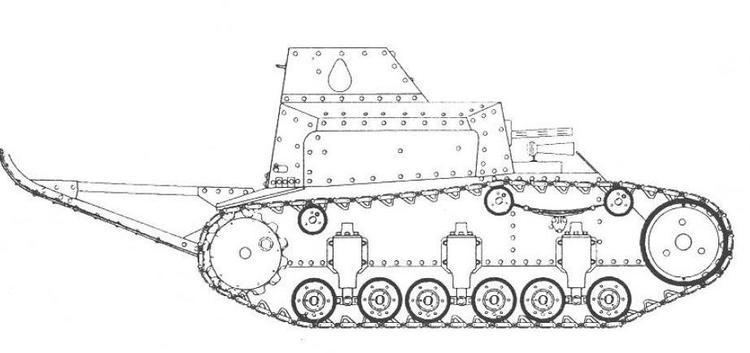Produced 1929 | Place of origin Soviet Union No. built 3 | |
 | ||
The T-17 tank was a one-man mechanized support tankette designed and developed by the Soviet Union during the Interwar period.
Contents
Development
In 1926, the design bureau (later OKMO) КБ Orudiyno-Arsenalny Trest (OAT) began work on a "Liliput" single man light reconnaissance tank. The development team faced several problems, including finding a new chassis and engine. The project was stalled continuously. On March 3, 1928, under the leadership of the head motor lab, AP Kushka involving LY Lalmena, as well as engineers, S. Ginzburg and E. Grote undertook the production of a new draft.
As part of a three-year plan to produce a force structure capable of conducting operational maneuver and infantry support, a mechanized and armored force was to be established by December 1930. In 1929 Field Regulation (Polevoi Ustay), declared that future war would be one of maneuver, developing the theory of successive operations by injecting the idea of motorization and mechanization into concepts for future offensive operations. The Ustay enunciated the aim of conducting deep battle to achieve success in penetrating the tactical depth of enemy defenses.
In May 1930 the Soviets created their first mechanized support brigade, consisting of 60 tanks and 32 tankettes (tankettes were light tanks armed with heavy machine guns).
Chassis and powertrain
The T-17 developers utilized the T-16 chassis and powertrain for the base model. The hull was based on the "Liliput". The power unit used was a 16 hp two-cylinder air-cooled engine. The chain track was made out of rubber and steel.
Superstructure and armaments
The superstructure, which sat atop the chassis of the T-17 (often referred to as, like its predecessor, "Liliput"), was riveted to the frame. The driver, located in the hull, also operated a machine gun mounted to the right of the longitudinal axis.
Testing
With long initial delays, a prototype was ready by the end of 1929. Despite problems, it was tested in January 1930. In June of that year, another test was conducted and showed better mobility than the T-18.
Modifications
One of the biggest drawbacks in tanks of this era was track failure. Therefore, one of the three tankettes ordered by the summer of 1930, was tested in a different track configuration. This second version of the T-17 had rubber tracks of the Kégresse type. However, the design was considered impractical, and it was decided to continue work on the full metal track versions, continued with the later production units of the T-18.
